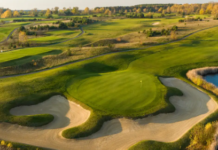By Andrew MarshallAround 100km from Paris in the northeast of France, is the historical province of Champagne-Ardenne, best known for its production of the world’s most famous sparkling wine. But it’s not just the grape that reigns supreme here – there’s ‘golf among the grapes’, with a collection of challenging and affordable courses for players of all abilities and some beautiful stately homes and châteaux to spend the night. These three elements of the good life that compliment each other, can provide a strong focus for visiting the region –enjoy a few rounds of golf, taste the champagne and stay at the châteaux…

GOLF AMONG THE GRAPES
There are several courses to play in this up-and-coming golf area of France. Get proceedings underway at arguably the pick of the bunch, by teeing off at Golf de Reims situated 8km west of Reims, in the middle of the famous vineyards. This picturesque, gently undulating 18-hole woodland course provides an attractive mix of tight tree-lined fairways and large elevated well-guarded greens in the beautiful surroundings of the 15th century Château des Dames surrounded by a moat.
Founded back in 1928 by the Reims and Épernay Champagne houses, the 6,055 metres par-72 course, which was originally a 9-hole layout, was later extended to 18 holes by Michael Fenn in 1973. To avoid the numerous trees that come into play, it’s important to plot a strategic route around the course and it’s not unusual on any given day to hear more sounds of golf balls hitting timber than woodpeckers during nesting season. At each tee-block the various Champagne Houses such as Moet & Chandon, Louis Roederer, Laurent Perrier, and Mumm advertise their produce, whetting the appetite for a flute or two of bubbly in the château clubhouse after the golf.
50km north-east of Reims on the outskirts of Fagnon village, is Golf de l’Abbaye de Sept Fontaines – a lovely 18-hole course built around an historic château nestling between valley and forest. The front nine is purely parkland with superb views of the château especially from the par-3 9th hole. Stop for lunch in the excellent restaurant before tackling the newer, more open back nine featuring characteristic rocky boulders landscaped around the greens.

Located in the south of Champagne-Ardenne near the small village of Chaource on the edge of the Aumont forest is Golf de Troyes-la Cordelière, previously the property of the Counts of Chandon de Briailles. Its 18 hole-course rolls over a vast carpet of gently undulating greenery, dotted with water features and ancient trees.
Other golfing options in the region include Golf de l’Ermitage (37km east of Troyes) with its par-3 12th signature hole and island green, La Grand Romanie (40km south-east of Reims), built on the site of an old Roman camp and Golf d’Arc en Barrois (80km south of Troyes), situated in the grounds of a château and featuring two lakes and elevated greens.

LAND OF THE LIQUID GOLD
In between rounds of golf, there are plenty of opportunities to experience the region’s famous product – champagne. Champagne is in fact a ‘sparkling wine’ and traditionally made using a blend of three varieties of grapes: Chardonnay, Pinot Noir and Pinot Meunier. Once the juice is extracted, champagne undergoes two fermentation processes, first in casks and the second after the wine has been bottled and had sugar and yeast added. This allows the carbon dioxide to get trapped in the wine, giving rise to those famous and distinctive bubbles. Non-sparkling wines are only fermented once in casks.
An excellent way to learn more about the champagne-making process is to explore the signposted roads that make up the Route Touristique du Champagne (Champagne Tourist Route) – 600km in total, divided into various circuits meander through the region’s principal wine-growing areas including Montagne de Reims (between the two champagne centres of Reims and Épernay), Côte des Blancs (south of Épernay) and further south, the Côte des Bar, specialising in smaller producteurs (champagne producers) that welcome thirsty golfers.
The provincial town of Épernay is the best place for champagne tasting, and underneath the streets of the ‘capital of bubbly’, in some 100km of subterranean cellars, millions of dusty bottles of sparkling wine are maturing side-by-side until one day being popped open in celebration. Épernay is home to some of the world’s most famous champagne houses such as Moët & Chandon, De Castellane and Mercier, the most popular brand in France. Many of them are situated on or near the Avenue de Champagne and offer entertaining, informative tours followed by tastings and a visit to the factory-outlet champagne shop.

Well worth a visit in nearby Rue Gambetta, is the cool bar and cellar combo of C. Commes Champagne, where you can sample champagne by the glass. 50 small independent winemakers from 50 villages in the main regions, are represented and each week they feature a selection of six different champagnes in 10cl glasses for €27.50. If you like a particular champagne, you simply walk down into the cellar below the bar and buy one.
From Épernay, it’s only a 6km drive north to Hautvillers, where champagne was first created three centuries ago. According to tradition, the ingenious idea of mixing various grape varieties from the Champagne-Ardenne region, and sealing the lot with a cork held in place with a wire collar to withstand the fermentation pressure, came from Dom Pérignon (1638 – 1715), cellar master at the Benedictine Abbey in Hautvillers.
Hautvillers is one of those picture-perfect French villages with a bar, church and a few pretty houses. In the square you’ll find the Tourist Office where, for a few euros, you get a gentle walking tour with an explanation of Pérignon’s life and the effect he had on perfecting champagne. The highlight is the Abbey where he is buried.
Northeast of Hautvillers, situated in the wooded hills around Verzy, is a totally new concept in enjoying champagne – the world’s first champagne bar in the trees. Le Perching Bar, is the brainchild of co-designers Germain Morisseau and Oliver Couteau, and sits on a wooden platform supported by 6-metre high stilts, accessed by a number of boardwalks suspended between the trees. Cool sounds emanate from the speakers, several local champagnes are on offer and the views are exceptional.
From Verzy, its only a flute or two of bubbly to Reims, a town with a rich history, and together with Épernay, is the most important centre of champagne production and home to some prestigious producers such as Mumm, Tattinger, Pommery and Louis Roederer.

ACCOMMODATION FIT FOR A KING
Staying at one of the 150 historic châteaux, manor houses or stately homes is an excellent way to experience France’s Champagne-Ardenne region and to complement the golfing and champagne lifestyle. A classic example is Château d’Etoges, situated 22 km south of Épernay in the small village of the same name surrounded by vineyards. Built at the beginning of the 17th century, Château d’Etoges was once a privileged place where the Kings of France enjoyed staying on their way to the east, and Louis XIV himself greatly admired the beauty of the château’s garden, fountains and ponds.
Overlooking a quintessential moat, this beautifully renovated château has twenty individually appointed bedrooms furnished with genuine antiques and tapestries. Downstairs, an imposing fireplace bears witness to banquets, meetings and celebrations from a medieval past. Classy French cuisine (with a good selection of wines and champagnes) is served in the adjoining L’Orangerie dining room, and after a tasty dinner it’s only a short stumble to your comfortable four-poster bed.
The château of choice for Reims, and nicely situated for playing Golf de Reims, is Château Les Crayères. Nestled discretely in a 7-hectare park with lush vegetation in the heart of the champagne city, this elegant home once owned by the Polignac family is now a luxurious gourmet retreat, where guests can relax in the twenty sumptuous rooms and where fine dining takes centre stage.
General manager Fabrice Mercier and Didier Elena, the head chef, set out to create the perfect restaurant and to combine it with the ultimate in accommodation. The restaurant is the main event, and any day at Château Les Crayères revolves around mealtimes and the sublime heights of the chef’s highly regarded cuisine awarded with two Michelin stars, and the extensive wine list with over 400 champagne labels.
North-east of Reims is Château de Montaubois, a beautiful 18th century building set in 4 hectares of parkland in Signy l’Abbaye. The owners, eccentric and likable Jean-François Monteil and his lovely wife Elizabeth have spent nearly three decades renovating the château to its former glory with original features and period furniture. They now offers B & B accommodation with 5 sumptuous rooms available to guests, delicious home cooked meals and a fascinating power point presentation about the history of the château and the renovation process. Château de Montaubois is conveniently located for playing Golf de l’Abbaye de Sept Fontaines which is only a short drive away.

Facts about Champagne
* Approximately 49 million bubbles can be found in a 750 ml champagne bottle that is stored at 20 ºC. Renowned scientist Bill Lembeck calculated this figure.
* The pressure in a champagne bottle is three times higher than in an automobile tyre, measuring at ninety pounds per square inch.
* The world’s tallest champagne glass stands at approximately seven feet and can hold up to 22 bottles of champagne. This glass was unveiled at a festival in Spotelo, a city in Italy.
* The name ‘champagne’ is copyrighted and the wine can be named as champagne only if it is produced in France’s Champagne region. If a similar wine is produced, using the same methodology, elsewhere other than Champagne, then it has to be labeled as methode champenoise so as to give credit to the procedure.
* Champagne goes particularly well with seafood, especially smoked salmon, lobsters, crabs and oysters.
* Heidsieck & Co Monopole Blue Top Champagne Brut was the champagne that was served on Titanic. There was a rumor that a few bottles of this champagne that were recently brought out of the wreckage still tasted fantastic.
* Marilyn Monroe is believed to have once taken a ‘champagne bath’ that took approximately 350 champagne bottles to fill the bathtub.
* A champagne cork leaves the bottle at a velocity of approximately 38-40 mph.
* Non-vintage champagnes are aged for at least 18 months and vintage champagnes aged for a minimum of three years and up to ten and are the most expensive.
* The temperature of the champagne should ideally be 6 to 8 degrees C
* Champagne should always be drunk in a tall narrow glass called a ‘flute’ to confine the bubbles and concentrate the aroma. To enhance the taste and aroma, the champagne should be allowed to sit for a few minutes after pouring into the glass.
* The size of the bubbles is one of the factors that determine the quality of the champagne. Tiny bubbles denote high-quality champagne. Large bubbles are a mark of inferior quality.
FACT FILE
Where to Play
Golf de Reims: www.golf-de-reims.com
Golf de l’Abbaye de Sept Fontaines: www.abbayeseptfontaines.fr
Golf de Troyes-la Cordelière: www.golfdetroyeslacordeliere.fr
Golf de l’Ermitage: www.golfdelermitage.com
Where to Stay
Le Château d’Etoges: www.etoges.com
Château de Montaubois: www.chateaudemontaubois.com
Château Les Crayères: www.lescrayeres.com
Where to drink & buy Champagne
Champagne Drappier: A family producer of excellent champagnes in the ‘Côte des Bar’ region. www.champagne-drappier.com
C Comme Champagne: Specialist champagne bar and boutique in Epernay with more than 350 champagnes available:
www.c-comme.fr
Route du Champagne (The Champagne Trail):
www.aube-champagne.com
Perching Bar (Arboxygene): The world’s first champagne bar in the trees on the outskirts of Verzy. www.arboxygene.eu
Where to dine
Reims / Restaurant Le Millenaire (1 star Michelin): www.lemillenaire.com
Epernay / La Cave a Champagne: www.la-cave-a-champagne.com
Further Information
French Government Tourist Office: www.franceguide.com
Champagne-Ardenne Tourisme: www.tourisme-champagne-ardenne.com









